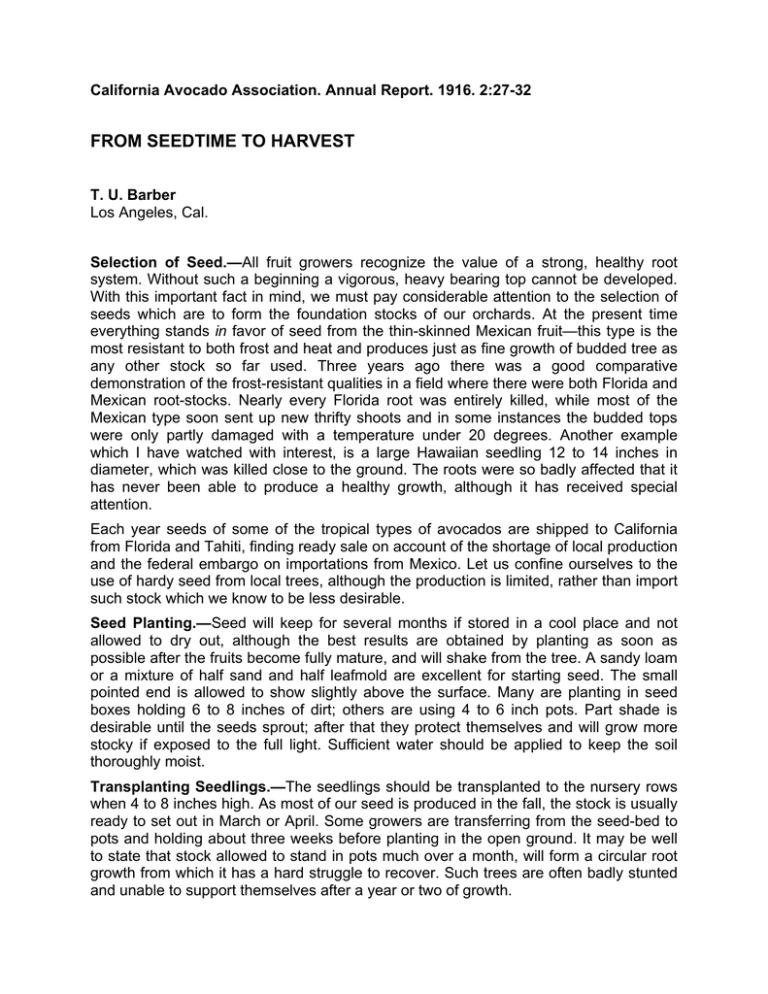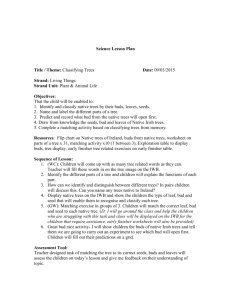FROM SEEDTIME TO HARVEST
advertisement

California Avocado Association. Annual Report. 1916. 2:27-32 FROM SEEDTIME TO HARVEST T. U. Barber Los Angeles, Cal. Selection of Seed.—All fruit growers recognize the value of a strong, healthy root system. Without such a beginning a vigorous, heavy bearing top cannot be developed. With this important fact in mind, we must pay considerable attention to the selection of seeds which are to form the foundation stocks of our orchards. At the present time everything stands in favor of seed from the thin-skinned Mexican fruit—this type is the most resistant to both frost and heat and produces just as fine growth of budded tree as any other stock so far used. Three years ago there was a good comparative demonstration of the frost-resistant qualities in a field where there were both Florida and Mexican root-stocks. Nearly every Florida root was entirely killed, while most of the Mexican type soon sent up new thrifty shoots and in some instances the budded tops were only partly damaged with a temperature under 20 degrees. Another example which I have watched with interest, is a large Hawaiian seedling 12 to 14 inches in diameter, which was killed close to the ground. The roots were so badly affected that it has never been able to produce a healthy growth, although it has received special attention. Each year seeds of some of the tropical types of avocados are shipped to California from Florida and Tahiti, finding ready sale on account of the shortage of local production and the federal embargo on importations from Mexico. Let us confine ourselves to the use of hardy seed from local trees, although the production is limited, rather than import such stock which we know to be less desirable. Seed Planting.—Seed will keep for several months if stored in a cool place and not allowed to dry out, although the best results are obtained by planting as soon as possible after the fruits become fully mature, and will shake from the tree. A sandy loam or a mixture of half sand and half leafmold are excellent for starting seed. The small pointed end is allowed to show slightly above the surface. Many are planting in seed boxes holding 6 to 8 inches of dirt; others are using 4 to 6 inch pots. Part shade is desirable until the seeds sprout; after that they protect themselves and will grow more stocky if exposed to the full light. Sufficient water should be applied to keep the soil thoroughly moist. Transplanting Seedlings.—The seedlings should be transplanted to the nursery rows when 4 to 8 inches high. As most of our seed is produced in the fall, the stock is usually ready to set out in March or April. Some growers are transferring from the seed-bed to pots and holding about three weeks before planting in the open ground. It may be well to state that stock allowed to stand in pots much over a month, will form a circular root growth from which it has a hard struggle to recover. Such trees are often badly stunted and unable to support themselves after a year or two of growth. Direct planting from the seed-bed to the field nursery is the most desirable but is not practical in too light a soil; it is far more difficult as the seedlings must have constant attention for the first few weeks until they are thoroughly established. It is necessary to furnish partial shade, such as a shingle on the south side, and to supply frequent irrigation, never allowing the ground to dry out around the roots. This method should be used only through the cool months of spring. The nursery rows should be 4 feet apart and the trees set every 18 inches in the rows. First class, one-year-old, budded stock will require this amount of space. Budding.—Stock planted in the field during April should be ready to bud the following August or September. The seedlings should be from one-half to one inch in diameter before budding. Budding in pots or boxes, which was practiced in Florida and thought to be necessary during the early development in California, is no longer followed, as it has been fully demonstrated that the field-grown tree produces a better stand in budding and a decidedly more vigorous tree when transplanted to the orchard. There are many individual ideas regarding the budding of avocado trees, the selection of budwood, and the subsequent care after the bud is inserted. No doubt some of the things practiced today will not be in use ten years from now. The following are my methods which I believe agree closely with other propagators who have made a study of this branch of the work. Budwood of the different varieties is not alike. In some kinds a bud which is slightly broken open can be used, while in others this advanced bud is sure to be unsuccessful; therefore it is necessary to become familiar with the wood to be used and learn which buds grow the best in each variety. In general, it is desirable to select a plump, mature bud which seems ready to start into growth. Early in the spring this wood is obtained from the last growth of the previous year, and later in the season from the new branches. This new growth must become fairly mature, which usually requires from six to ten weeks. Very little success is obtained in using budwood from the soft tips. If possible, cut a shield bud not under an inch and a half in length, leaving a small piece of wood attached. It is best to leave a short piece of the leaf stem to push on while inserting the bud. This also protects the bud from the wrapping. The common T-shaped cut is made, being careful not to break the bark in placing the bud. The sap must be flowing freely so that the bark separates readily or the work will be a failure. Waxed tape is generally used, although some propagators are using plain tape or cotton string with good results. The bud must be tied extremely tight, being careful to leave the eye exposed; it is also well to secure the wrap by slipping the end under the last loop, as many buds are lost by a slight spreading of the bark. . At the end of three weeks, a second wrapping of plain cloth is required to allow the proper expansion and still hold the bark from spreading away. This in turn can be removed at the end of four weeks. The seedling tops are cut back gradually to start the bud into growth, always allowing a few leaves to remain to aid in keeping up the flow of sap above the bud. The avocado will not stand the complete topping, so often practiced in citrus work. The bud should be at least 6 inches high and contain some mature wood before the entire stubbing can be made. This is most satisfactory if practiced through the cool months of spring. After the bud is started, it should be tied with raffia every few weeks in order to make a straight trunk. The seedling top can be used to good advantage in this work until the bud is large enough to require staking. The suckers and branches should be kept off until the tree reaches a height of 24 to 30 inches, when, it will generally form a perfect head of four or more branches. In some cases it may be necessary to pinch out the terminal bud to force this branching at the proper place. Stock grown in this manner soon shades itself and makes a beautiful, well-shaped tree. Transplanting to Orchard.—Avocados are best removed from the nursery during the spring months. In preparing the trees for balling it is essential to trim off about one-half of all well-branched stock, and in some cases to remove part of the remaining foliage, or cut the leaves in half. So far but little success has come from transplanting bare roots, while trees balled with plenty of earth have started into new growth in a short time. It is important to harden off the stock in a lath-house with the roots packed in damp shavings for ten days before planting. General Orchard Notes.—Most of the trees in orchard plantings up to the present time are from 20 to 30 feet apart. The oldest demonstrations of budded stock in California are about five years of age, and at this early stage show a spread of from 10 to 15 feet. It is impossible to say just how much space a mature, budded tree will require. Certain varieties show a very marked difference in growth, and it is quite probable that some may require twice as much space as others. In preparing the holes it is well to dig at least 2 feet deep and as much in width, breaking in the sides so that the young roots have plenty of loose soil in which to start. Plant a little deeper than the tree stood in the nursery, leaving the bud-union slightly above the surface as precaution against decay, and consequent disease at this point. Water must follow the planting closely and be supplied several times during the first month; the best results have been obtained from irrigating twice each month during the warm part of the first year. The mature tree is expected to require about the same amount of irrigation as our citrus groves receive. It is best to stake the trees from the start; the new growth is generally too much for the young trunks to support in a strong wind. Some protection from the sun is one of the most essential things to bear in mind. Until the bark has turned completely brown the sun will burn it so badly that the scar is hard to cover. All kinds of burlap shades are used for this purpose, also newspapers and manufactured tree protectors. Some of us are using with success, a whitewash made with salt, tallow and quicklime. It must be fairly heavy and is applied with a brush to the south side of the trunk and exposed branches. After the tree is two years old it will usually shade itself. If frost protection is considered necessary, any of the methods used in our citrus groves will be found satisfactory. Young trees are often wrapped in burlap or corn-stalks during the first two winters. This should be removed as early in the season as possible, on account of a mildew which sometimes forms during the rainy season. Cultivation.—The ground should be kept in a loose condition by cultivation after irrigation, although it is not good to work the ground very deep close to the tree, so as to disturb the young roots. A good mulch will both supply shade for the roots and help keep a more constant supply of moisture. This should be removed or worked into the ground before the winter rains start. Fertilizer.—So far but very little fertilizer has been required, and that supplied has generally been barnyard manure. Bone or blood will produce excellent growth, but what effect they have on fruit production has rot been demonstrated. I hope the owners of the young groves which are now reaching the bearing age will keep careful records which can be published by this Association from time to time. Pruning.—In every fruit industry there always are different ideas on pruning. This is often brought about by the individual habits of varieties. The avocado certainly shows considerable variation, and it is to be expected that some varieties will be discarded on account of undesirable growth. There are, however, certain general principles to be followed in forming the framework. The trees should be allowed to branch from 20 to 30 inches above the ground, and even higher in some varieties which have a drooping habit. These four or more branches will form the main body of the tree. Next the main limbs should be forced to branching not more than 2 feet from the trunk. This can easily be done by pinching out each terminal. The small lateral branches produced in this manner will carry numerous fruit spurs, and largely increase the bearing surface. Some valuable varieties which have a natural tendency of drooping, can easily be controlled by light pruning to force the lateral branches. This should be done every two or three months during the growing season. When such trees are properly cared for, they produce beautiful compact heads that are fully protected from sunburn. The question of topping the slender pyramid type such as the "Lyon" is one which should be discussed. How high should they be allowed to grow? Can they be forced into spreading, as the other varieties do, or must they be allowed to grow extremely tall and plant more to the acre? Certain trees send out one branch which grows twice as fast as the others, in some cases even dwarfing the main trunks. These should be heavily pruned or entirely removed. All pruning should be done with very sharp tools, each cut being left entirely smooth and close to the bud which is left to make the next growth. If the cuts are large they need painting over with a heavy shellac or asphaltum tree paint. Many places are noticeable where the limbs have been badly affected with die-back from lack of care. The wounds will usually heal over in time; yet if not properly cared for, will always contain a small portion of dead wood, which is subject to disease. In closing I wish to call attention to the value of tree records as presented to the last meeting by Mr. Shamel. It is very important that not only production records be kept, but special notes on the habit of growth, results from pruning and many other equally important subjects. Even as early as this the present season many budded trees are setting fruit. There is bound to be variation, the records of which will greatly help not only the individual grower, but the entire industry. DISCUSSION Mr. Whedon: Have you had any experience in irrigating when the tree begins to set its fruit? Is it better to irrigate then or later? Mr. Barber: Has anyone had any experience along that line? Mr. Whedon: I will give you a little of my experience. I had a tree that set half a dozen fruit as large as a small egg and I prided myself on having the first avocados in the neighborhood. To my surprise in a few weeks, they all dropped off. I then turned the water on and what buds were there set fruit and I have now ten times as much fruit as before. I have a number of trees just commencing to set fruit and they seem to appreciate the water as shown by the setting fruit. Mr. Barber: Mr. Whedon's statements in regard to what he has done certainly follow the results in Florida. Mr. Simmons, who is in charge of the Government station at Miami, states that in the years when they had lots of rain they had lots of avocados. Mr. Fessler: I would like to give my experience in using blood on young trees in the spring when just blooming. It is not well to use the blood too early during the blooming period, but if we wait until the bloom gets fairly well out, then it can be put on with good results. Question: What is the best time to bud? Mr. Barber: The budding season starts usually about the first of April. It lasts for a period of about ten days, but is limited on account of the supply of budwood. As soon as the season's growth starts, you cannot obtain any more good budwood for six or eight weeks. Just exactly which budding season is the best I could not say. Mr. Metcalf: About pruning trees, I would state that my experience has been that if you prune anything off at all, the trunk does not grow in proportion to the top where you prune, but if you let it grow right from the bottom you will have a trunk large and symmetrical. Mr. Whedon: I want to qualify my statement made last October in regard to pruning trees. What was meant was not that they would die immediately, but that they would develop hollow trees. I planted 79 trees in 1913. The nursery man trimmed them back about as he would lemon trees and never painted them. About three months afterwards I went to examining them and found that the pith had died back. In every one the pith had died back several inches, so that the pruning does not necessarily kill the tree immediately, but when you have a hollow tree, it will not live long. Question: How late in the spring can trees be put out? Mr. Barber: I should say it would depend on the district. You could still set through June, but I don't think it advisable to set in June unless you are willing to give them special care. February, March, April and May are the best months. Question: I would like to ask how much irrigation the trees should have? Mr. Barber: The frequency of irrigation depends on the soil. If you have a light soil, irrigate every week; if a heavy soil, every two weeks. You can't do them any harm if you irrigate every week.





